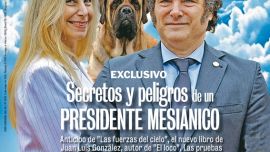Rarely able to control events, governments here have tended to fall back on control of the agenda and of the street – with the latter so relative in this pandemic year, the former becomes all the more vital but has started spinning dangerously beyond the Alberto Fernández administration’s grasp this week, starting last Tuesday.
September 15 (the anniversary of the late lamented Buenos Aires Herald) is more widely known as the traditional date for submitting the annual budget and so it was scripted as the day’s big event – some 10 days after formalising the bond swap granting Argentina almost US$40 billion of debt relief and supposedly calming the money markets, creditors would be given the closest thing to the plan to which President Fernández is so allergic, in the form of the 2021 budget. But the timely submission of that budget to Congress ended up being a few paragraphs buried deep inside Wednesday’s newspapers as the government added monetary lockdown to the one already precariously in place on the sanitary front. The only area where the agenda does remain under government control could prove equally self-destructive – Vice-President Cristina Fernández de Kirchner’s autistic use of the Senate to ease her legal problems is moving full speed ahead but risks alienating an electorate urgently needing answers to crippling economic and health problems.
The intensified capital controls so rattling market confidence may have been a hasty improvisation but were in no way on the spur of the moment – on the contrary, they stem from months of procrastination and denial. The cost of those wasted months of debt negotiation is now coming home – if the offer finally made had been prompter, the economy could have been relaunched during the presidential honeymoon with net Central Bank reserves still in 11 digits instead of the exit from default coming too late to stop the rot.
The response to the erosion of Central Bank reserves was equally delayed with again dire consequences. Nobody can deny that something had to be done with even the modest sum of US$200 in monthly purchases no longer sustainable nor that such panic hoarding of scarce greenbacks rather than importing inputs or productive investment is hardly the best use. But the remedy chosen does more to create new difficulties than to solve the problem.
For a start the procrastination of President Fernández has trapped him into an exit strategy contradicting his own premises – the last time capital controls were this tight in the last two years of Kirchnerite presidency (2013-2015), he commented sagely enough that when dollars are prevented from leaving the country, they are also barred entry. But this week’s measures go further than merely repeating the past errors so firmly criticised by Fernández at the time in adding a new dimension. The existing controls could simply have been tightened to, say, a yearly cap of US$500 instead of a monthly US$200 for saver purchases or a dual exchange rate for commercial and financial dollars could have been experimented to absorb the gap between the official and parallel rates as well as to distinguish between productive and speculative uses. But instead the main innovation of the latest measures has been to place the burden on private companies by obliging them to refinance 60 percent of their capital debts, thus virtually forcing them into default – after so much trouble to restore access to international credit, it is now being negated for the private sector. Companies will now have to look elsewhere for pre-financing exports and reallocate potential investments towards capital debt repayment when the government constantly plugs exports and investment as the key to clinching dollars and growth.
The measures also directly address the drainage on reserves of the US$200 multiplied millions of times by adding a 35 percent surcharge to the 30 percent PAIS tax, a move which will be felt by far more people, but thus far this has only served to push up the “blue” dollar, thus increasing inflationary pressures – a situation hard to avoid with so many pesos being printed while the dollars from a bulging trade surplus have yet to appear.
Hard to draw any conclusions when the government leaps from one problem or conflict to another (as the week closes with a Senate bill to slash the City’s revenue-sharing cut back to its pre-2015 level of 1.4 percent) – something not to be confused with control of the agenda.






















Comments